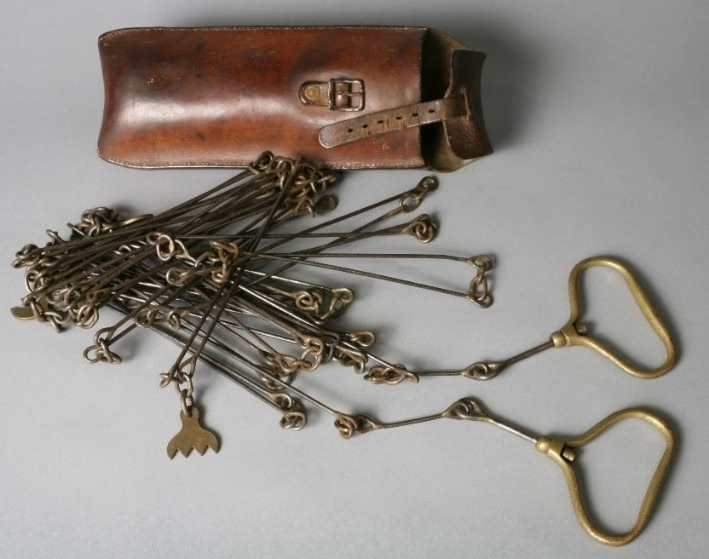Measurements play a crucial role in every aspect of life, from the kitchen to engineering and construction. Accurate measurements ensure precision in tasks, and surveying, a fundamental aspect of engineering, heavily relies on tools designed for this purpose. Among these tools, chains are one of the most essential instruments for measurement in surveying. This article explores the components, types, testing methods, and advantages of chains used in surveying.

Parts of Chains Used in Surveying
Chains consist of several components designed to facilitate ease of handling and accurate measurement:
- Brass Handles with Swivel Joints: Located at the ends of the chain, these allow for smooth rolling and unrolling without tangling or knots.
- Tally Markers: Markings are placed at every 10th, 20th, and 40th link to simplify reading measurements.
- Circular Tally: Positioned at the center of the chain, this helps in quick and accurate measurement reading.
These thoughtful designs make chains a practical choice for various surveying tasks.
Types of Chains Used in Surveying
Chains are categorized based on their length and application. Below are the most commonly used types:
- Metric Chains:
- Widely used in India.
- Available in lengths of 5m, 10m, 20m, and 30m, with 20m being the most common.
- Tallies are provided every 2m, and each link is 0.2m in length.
- Steel Band or Band Chains:
- Made of a narrow strip of steel, with a uniform width of 12-16mm.
- Divided by brass studs or engraved graduations at every 20cm.
- Commonly used in lengths of 20m and 30m, wound on metal reels for convenience.
- Gunter’s Chain (Surveyor’s Chain):
- Standard length is 66ft, with 100 links of 0.66ft each.
- Convenient for land measurements, where 10 chains equal 1 furlong and 80 chains make a mile.
- Engineer’s Chain:
- Measures 100ft in length, with links of 1ft each.
- Equipped with brass rings or tags at every 10 links for easier reading.
- Revenue Chain:
- Standard length of 33ft, consisting of 16 links, each 2ft long.
- Frequently used in cadastral surveys.
Testing and Adjustment of Chains
As chains are made of metal, they are prone to changes in length due to environmental and usage factors. Proper testing and adjustments are essential for maintaining accuracy.
- Causes of Shortened Length:
- Bending of links.
- Accumulation of mud in rings.
- Causes of Lengthened Chain:
- Opening of rings.
- Surface wear on links.
Testing Methods:
- Comparing chain length to a steel tape.
- Using a permanent test gauge or field pegs driven at precise distances.
Adjustments:
- For Long Chains: Close joints, reshape elongated rings, remove worn rings.
- For Short Chains: Straighten links, replace small rings with larger ones, or insert additional rings.
Errors in Chain Surveying
Errors can significantly affect the accuracy of measurements. These errors are categorized as follows:
- Personal Errors:
- Mistakes in reading, recording, or interpreting measurements.
- Often serious and difficult to detect.
- Compensating Errors:
- Occur randomly and may offset each other when many measurements are taken.
- Examples include incorrect end markings or slight inaccuracies in chain graduations.
- Cumulative Errors:
- Always occur in the same direction, leading to significant deviations.
- Examples include poor ranging, erroneous chain length, temperature variations, and sagging on slopes.
Advantages and Disadvantages of Chains in Surveying
Advantages:
- Chains are simple and widely used in surveying.
- The tools are easy to use, maintain, and replace.
- Few people are needed for a chain survey, reducing costs.
- Minimal mathematical calculations are involved, making it accessible to all skill levels.
Disadvantages:
- Chain surveys are unsuitable for large or built-up areas.
- The method is prone to errors, particularly if the chain is not properly maintained.
- Surveys in steep or waterlogged areas are challenging and time-consuming.
- Obstacles, such as raised points, complicate the process.
Conclusion
Chains remain an essential instrument in surveying due to their simplicity and effectiveness. While they come with limitations, their advantages make them invaluable for small-scale projects and basic land measurements. Proper maintenance, testing, and adjustments can mitigate errors, ensuring accurate and reliable results. Despite advancements in technology, chains continue to hold their place in the realm of engineering and surveying.
